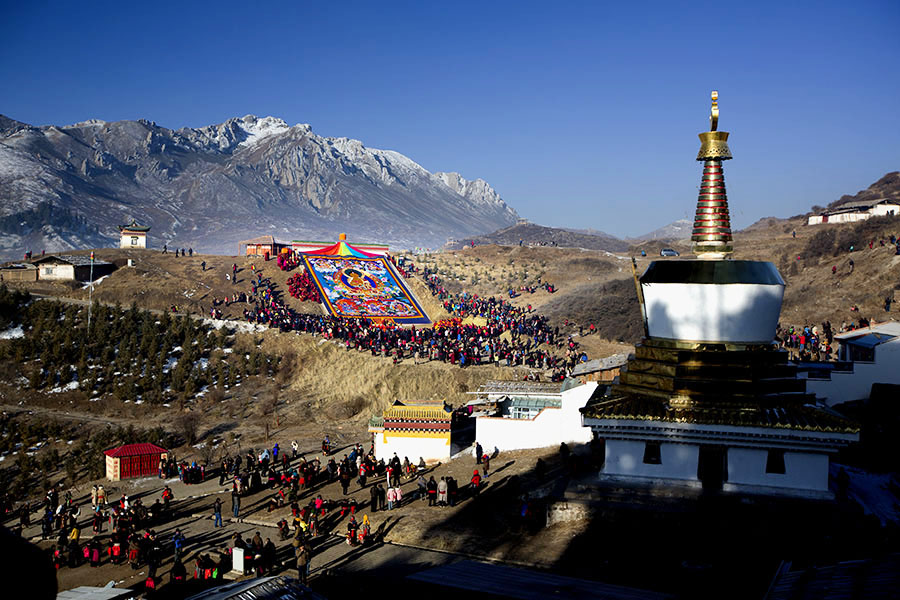
Langmusi (also known as Taktsang Lhamo in Tibetan) is a small, picturesque town nestled in the border region between Gansu and Sichuan provinces in western China. Known for its breathtaking natural beauty, Langmusi is surrounded by lush forests, flowing rivers, and the striking hills of the Amdo Tibetan plateau. It is a cultural and spiritual hub, home to two Tibetan Buddhist monasteries and a community of both Tibetan and Hui Muslim populations. Langmusi offers visitors an authentic Tibetan cultural experience in a tranquil setting far from the busier tourist areas of Tibet and Qinghai.
Sertri Monastery (Gansu Side)
Located on the Sichuan side of Langmusi, Sertri Monastery is one of the two main monasteries in the town. This Gelugpa (Yellow Hat sect) monastery sits on a hill overlooking Langmusi and is a major center for local Tibetan worship.
Visitors can explore the monastery’s prayer halls and stupas while enjoying sweeping views of Langmusi town and the surrounding landscape. Sertri Monastery is known for its unique rock carvings and frescoes depicting Buddhist stories. Monks often gather here for traditional chanting and rituals.
Kirti Monastery (Sichuan Side)
Kirti Monastery, situated on the Gansu side of Langmusi, is another significant Gelugpa institution. The monastery, which has long been a center for Buddhist study and rituals, has an important influence in the area.
Inside the monastery, visitors can see colorful statues, murals, and prayer wheels. The monks’ daily rituals are open to the public, allowing for a close look at Tibetan Buddhist practices. Kirti Monastery also features annual festivals with Cham dances, elaborate costumes, and colorful ceremonies.
Sky Burial Site
Sky burials are a traditional Tibetan funerary practice, where the deceased’s body is offered to vultures on mountaintops, symbolizing the transience of life and the return to nature. In Langmusi, there is a dedicated site for sky burials, located in the hills near the town.
While witnessing a sky burial may not be possible or appropriate for all visitors, understanding the significance of this practice adds a profound dimension to the cultural and spiritual experience of Langmusi.
White Dragon River (Bailongjiang) and Hiking Trails
The White Dragon River flows through the center of Langmusi, dividing the town into the Gansu and Sichuan sides. The river is flanked by scenic trails that lead up into the surrounding hills and grasslands.
Popular hiking trails around the town include paths to the hills above Sertri and Kirti Monasteries. These hikes offer incredible views of the grasslands, forests, and snowy peaks that surround Langmusi. Travelers can also follow the White Dragon River deeper into the mountains, where they might encounter Tibetan nomads and grazing yaks.
Langmusi’s Local Tibetan Culture
Langmusi is inhabited by a mix of Tibetan and Hui Muslim communities, giving the town a unique cultural blend. Tibetan families in the area continue traditional lifestyles, and the town is dotted with Tibetan teahouses, guesthouses, and small shops selling handmade crafts and religious artifacts.
Visitors can sample Tibetan butter tea, yak meat, and Tibetan barley dishes in local eateries. Many guesthouses are run by Tibetan families who warmly welcome visitors, making it possible to experience Tibetan hospitality firsthand.
Cham Dance Festivals
Both Kirti and Sertri Monasteries hold Cham dances during significant Buddhist festivals, particularly during Losar (the Tibetan New Year) and other religious events.
The Cham dances, performed by monks in vibrant costumes and masks, depict stories from Buddhist mythology. These ritual dances are thought to drive away evil spirits and bring blessings to the land and people, providing an enchanting cultural experience for visitors.
Travel Tips for Visiting Langmusi
- Best Time to Visit: Spring (April to June) and autumn (September to October) offer the best weather, with mild temperatures and clear skies. Winter brings colder temperatures but can be ideal if you want to experience Tibetan festivals like Losar.
- Respect for Local Customs: Tibetan Buddhist customs are deeply ingrained in Langmusi’s culture. When visiting monasteries, dress modestly, avoid loud noises, and refrain from taking photos in prayer halls unless permitted.
- Altitude Considerations: Langmusi is situated at around 3,300 meters (10,826 feet) above sea level. Take time to acclimate, stay hydrated, and avoid strenuous activity on your first day to prevent altitude sickness.
- Accommodations: There are several guesthouses and small hotels, many of which are Tibetan-run, offering traditional meals and cultural insights. For a unique experience, consider staying in a Tibetan guesthouse.
Langmusi, with its serene monasteries, traditional Tibetan customs, and scenic surroundings, offers an authentic look into Tibetan Buddhist culture in a peaceful mountain setting. For travelers seeking a spiritual retreat or an immersive cultural experience, Langmusi is a hidden gem on the Tibetan plateau.
 Tibet World Travel Tibet Tour, Tibet Trip, Tibet Travel, Tibet Train, Tibet Trekking,
Tibet World Travel Tibet Tour, Tibet Trip, Tibet Travel, Tibet Train, Tibet Trekking,
